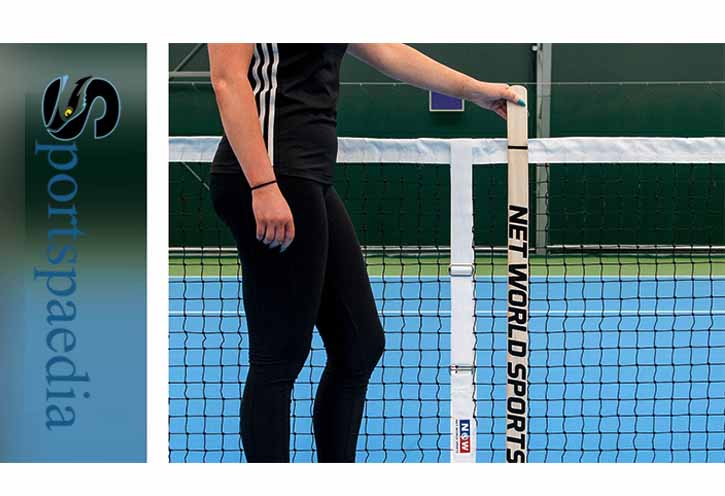Do you know why the middle of your tennis net is sagging? Look nowhere else! We conducted studies to learn specifically why tennis netting sags. Continue reading to see why having too much sagging will make your gameplay worse.

According to the official tennis rules, a tennis net’s middle must be 3 feet tall, which is a little shorter than all poles that support it. Playability is the cause of a tiny sag in the middle.
In the end, a lower middle tennis net makes it the easiest portion of the net to climb over, whereas the sides are thought to be more difficult because the net is higher there. This encourages the use of strategy and the growth of player abilities.
What Should the Height of the Tennis Net Be?
To begin with, understanding the basics of the internet is crucial. The lowest point of a tennis net was 3 feet high, as was already mentioned. Two pillars that each measure three feet, and six inches tall keep the net in place. The natural droop that is typical in a tennis net is caused by the six-inch height differential between the posts and the middle of the ball net.
The Net Sags: Why?
People use a tactic because there is a normal sag in the tennis net. Each shot would have exactly the same chance to score if the net had the same height throughout.
There is a purpose because people frequently hit cross-court shots and serve over the middle of the court; the next is a little bit shorter there, increasing the likelihood that it will go in.
For instance, a cross-court shot and a shot down the line would easily match if the net had the same height across. Games would end quickly as people would not waste any time going for the quick shot that clips the line.
Professional players like to rally that much until one chooses to try for the killing line shot since cross-court goals are easier to make when there is a sag in the center of the court.
While certain sag is expected in tennis, so much sag will be detrimental to the sport and players’ abilities. Read on to discover why the incorrect quantity of sag will interfere with real gameplay; it is discussed in the following section.
How a Sagging net too Much can Impact the Game
Playing without the sagging net is never good for overall playability for two main reasons:
- Shots are fired that shouldn’t have been fired.
- Your stroke is impacted.
Now, you might be wondering how exactly these two are so. Continue reading to find out how the game is impacted and how your own game is as well!
Inaccurate Shots/Game Change
A ball has a greater chance of crossing a net when it sags or drops. In tennis, your goal is to return the ball and maintain the play. You want to use expertise and technique to outwit your adversary.
Balls that would not have made it within the first round will go over if a net is drooping, changing the result of a game. All of us have experienced or witnessed such trick shots that manage to clear the net despite clipping the top.
Imagine doing that while standing on a drooping net. While you might become ecstatic if the cards fall your way, you’ll feel angry or frustrated if you’re the one who’s being taken advantage of. In the end, if two goals in a match are made possible by slipping past a net that is sagging, it equates to two faulty points.
The same player would have missed that shot into the net in a game with a decent net & lost a point, but they now have the game and, who knows, maybe even the set in hand. Thus, these “mistake shots” changed the game’s result.
Incorrect Strokes
More specifically, your stroke is impacted. It is always advised by pros and tennis teachers to miss long rather than in a ball net. You won’t notice the mistake in your stroke if you’re performing with a drooping net and shots which shouldn’t cross the goal post.
You’ll be pleased that your shot missed, but you’ll fail to see why it shouldn’t have. Although smashing balls over the net costs you points, tennis players learn from these mistakes and try to avoid them in the future. You won’t learn if you’re practicing with a dropping net.
However, you may take pride in earning a point that wasn’t yours to receive, but you won’t grow as a result. You will notice the flaws once you perform on a perfect net if you are constantly using a flawed net.
How Is A Tennis Net Set Up?
Please take note that the step-by-step instruction begins with the posts already having been placed in the court.
The ends of the net should line up with the poles as it is spread out across the court.
For both sides, seize the netting cable and fasten it to the wire hook (also known as a cleat). Tighten the net cord with the crank while leaving a small amount of slack in the net.
the net’s center. Pull the net until it is in place on each side.
Incorporate the net dowels. These fit into the opening along the net’s outer edges.
Crank the net until it is completely stretched after inserting the dowels. Keep in mind the net height, which is three feet, and take precise measurements.
Check out this simple and effective YouTube video that demonstrates how to set up the tennis net if you learn best visually.
Related Post;
- What is the Hardest Sport?
- 10 Weirdest Sports in the World You Didn’t Know
- Top 10 Best Free Sports Streaming Websites
